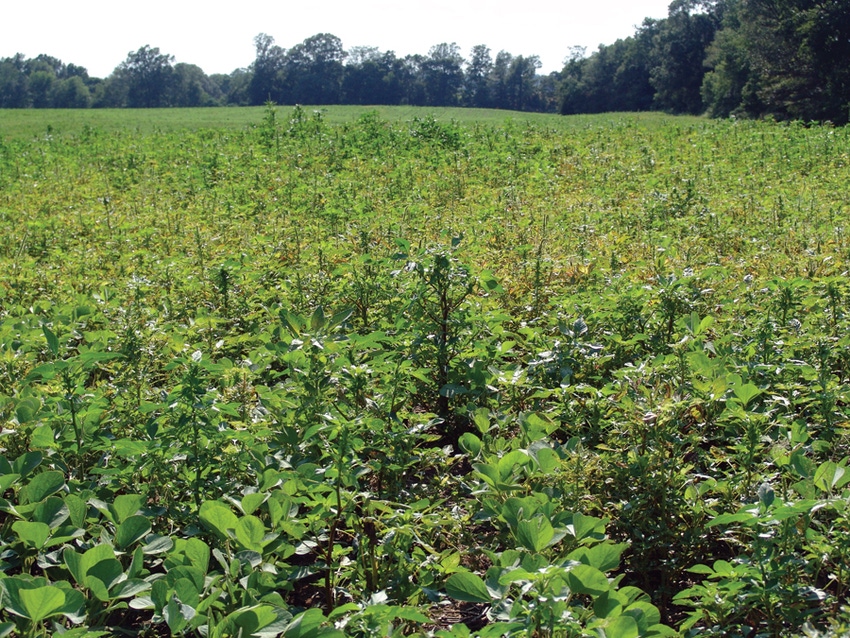
With no pre-applied herbicides, pigweeds take control
A number of west Tennessee soybean fields that had no pre-applied herbicides were taken over by resistant pigweed this spring. Some will have to be destroyed and replanted with a pre-applied herbicide.On emerged pigweed, growers spraying Ignite over glufosinate-tolerant cotton for Palmer pigweed are getting good control as long as the pigweed is less than 6 inches tall.Mixing an ALS-inhibiting herbicide with glyphosate on a glyphosate-resistant Palmer amaranth population may only provide control ranging from 20 percent to 50 percent.
June 22, 2011

“These pigweeds are kicking our #&^.” That quote from a county agent to me the other day fully defines the weed issues in many soybean and cotton fields. A number of soybean fields that did not have a pre-applied herbicide had become partially or completely overrun with Palmer amaranth by last week. Some of these fields will be destroyed this week (June 21) and replanted with a pre-applied herbicide this time.
Others where large patches of Palmer are the issue will be either partially destroyed and replanted or sprayed several more times with a PPO herbicide. Neither option is a good one. Part of the problem has been the good wheat crop. By the time the wheat was harvested and doubled-cropped, the Palmer in the earlier soybean fields planted in May had become too large for a fomesafen (Flexstar, Reflex, Prefix, Rhythm, Dawn, etc.) to control.
Other issues have been folks who thought they could get by one more year without glyphosate-resistant Palmer showing up in their fields. They sprayed glyphosate two weeks ago and found out glyphosate was no longer effective on their Palmer. By the time they made this determination the Palmer had become greater than 4 inches tall and too large to effectively control with fomesafen. Still others applied a fomesafen product more timely to the Palmer (less than 4 inches) tall but still got inconsistent control.
In these cases, the pigweed population was thick, making it hard to get good coverage. Moreover, the Palmer had hardened off due to the three week stretch of dry and hot weather which did not allow the fomesafen to work well. In many cases the herbicide took the terminal out of the pigweed and it started growing back from lateral buds.
All the issues in mid-June bring to mind the fact that many of the pre-applied herbicides applied in late-May/early-June will begin to play out over the next couple of weeks. They have started to do so in our tests in mid-June. Everyone should be monitoring soybean fields for newly emerged Palmer amaranth and be ready to have them sprayed timely!
In cotton fields, many growers are over-spraying with Ignite to control the Palmer amaranth. In most cases, they are getting good control on Palmer amaranth if they can catch it before it gets too large (6 inches). The injury to Liberty Link cotton from Ignite applications has been non-existent. The injury to WideStrike cotton has been more mixed. When the Ignite was applied before the rain events, cotton injury was very minor. However, after the rain and the increase in humidity the injury from an Ignite application to WideStrike cotton has become more pronounced. The level of injury varies between 15 percent to 25 percent depending upon what is tank-mixed with it.
The fields planted to just a Roundup Ready Flex variety with emerged Palmer amaranth have been the most challenging to manage. Some folks who are just getting introduced to glyphosate-resistant Palmer ask about tank-mixing a ALS-inhibiting herbicide with glyphosate to control it. Unfortunately, the resistant Palmer developed back in the 1980s and early 1990s is very prevalent today. The result is that mixing an ALS-inhibiting herbicide in with glyphosate on a glyphosate-resistant Palmer amaranth population will only provide control ranging from 20 percent to 50 percent. Others have tried applying Cotoran plus either MSMA or a surfactant over the top as a rescue treatment. These applications burn the cotton and the pigweed; both typically have grown back. There has been some Palmer control from these applications, but typically on very small pigweeds. Most have started running hooded applications on this cotton despite the cotton still being small for this type of herbicide application. Finally, we are seeing chopping crews out in these fields. Summer unemployment should not be a problem for anyone willing to chop pigweeds in July and August.
About the Author(s)
You May Also Like



